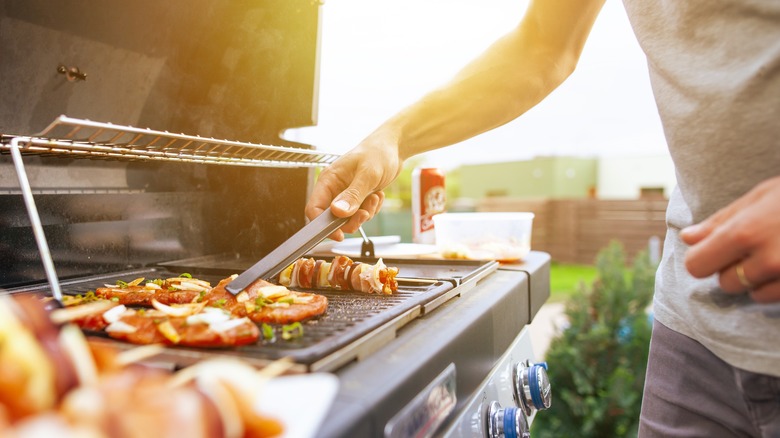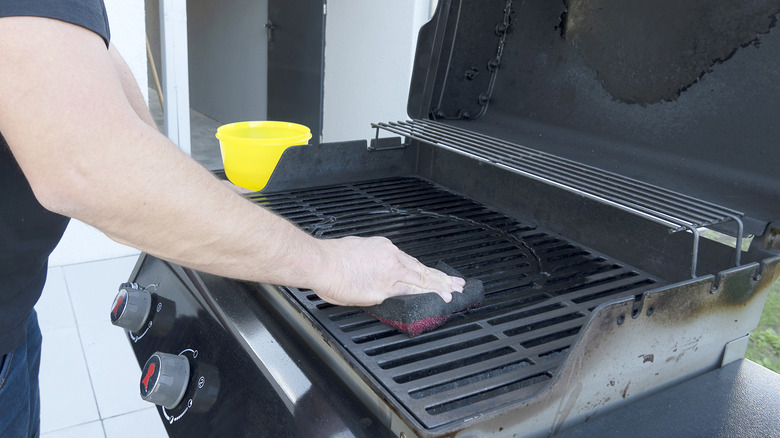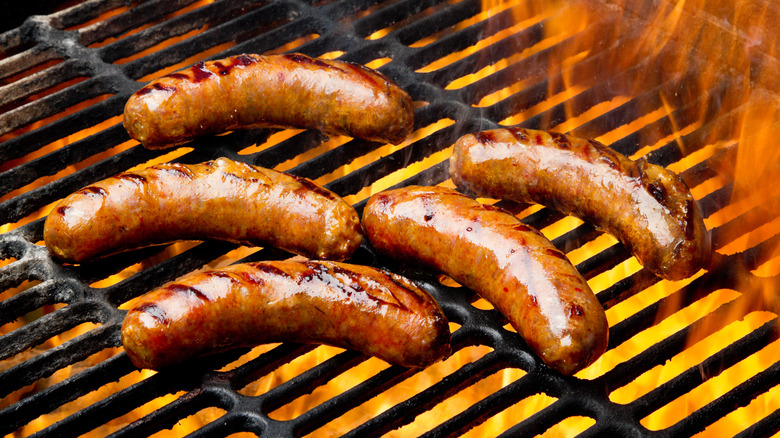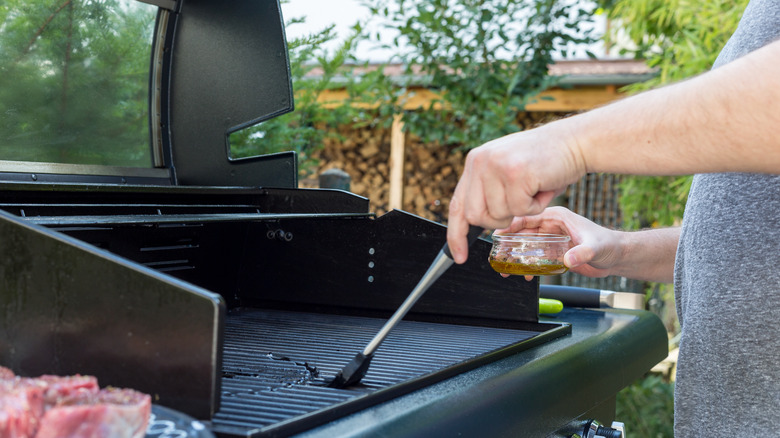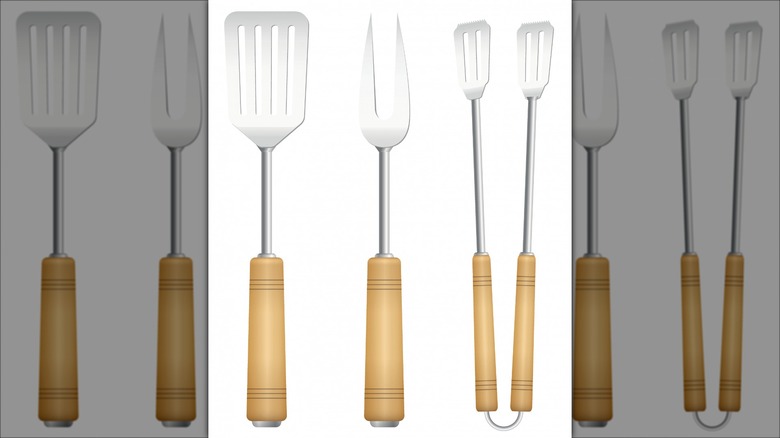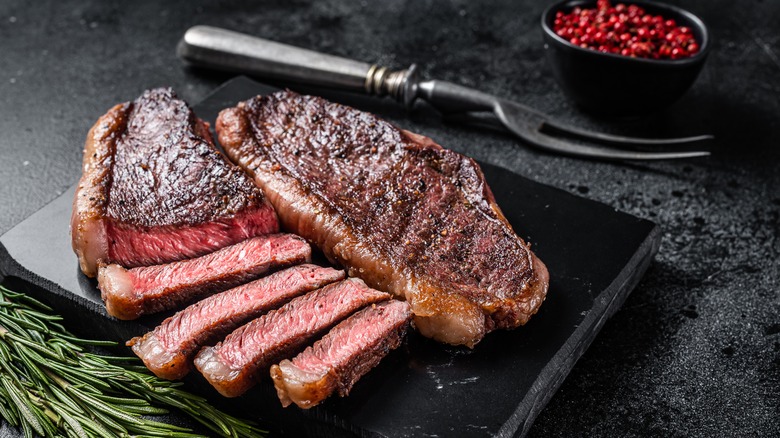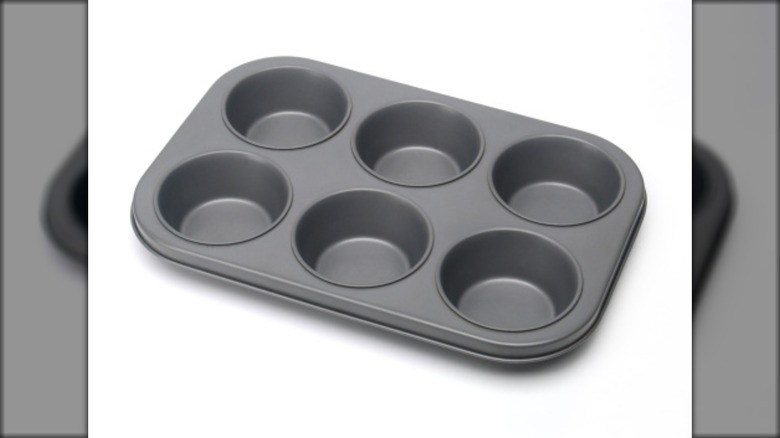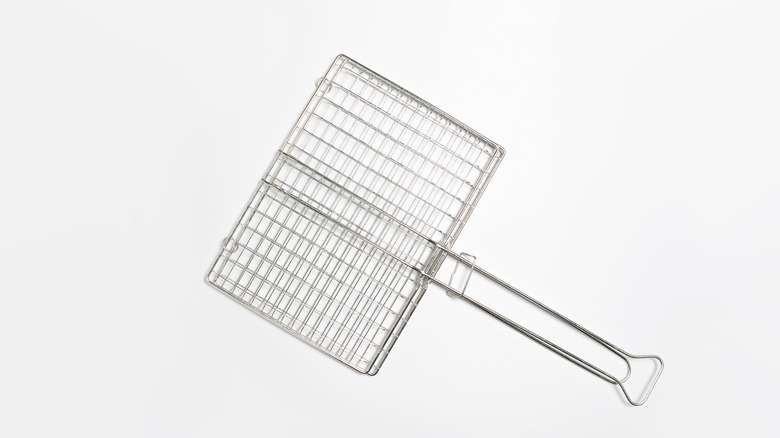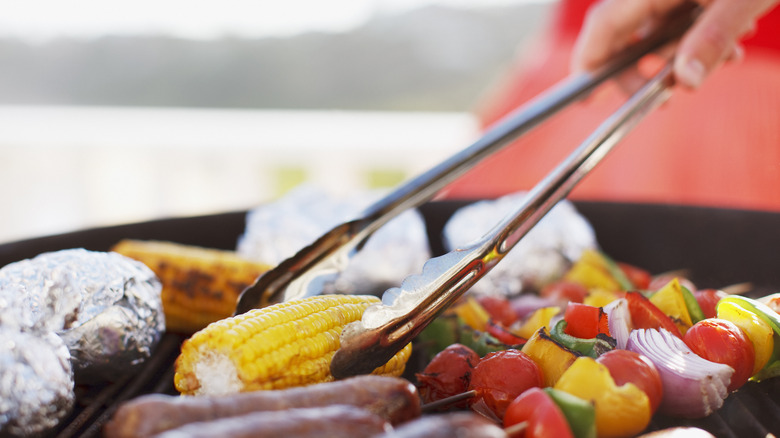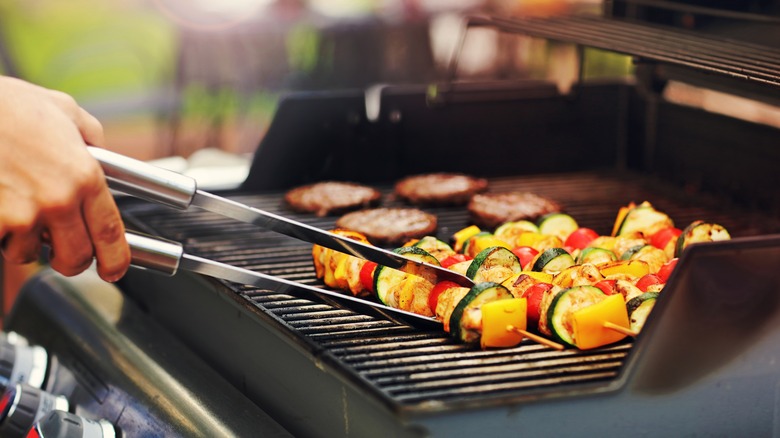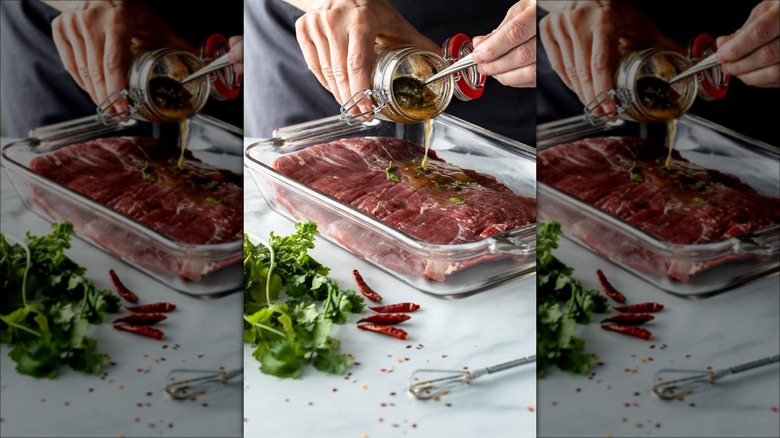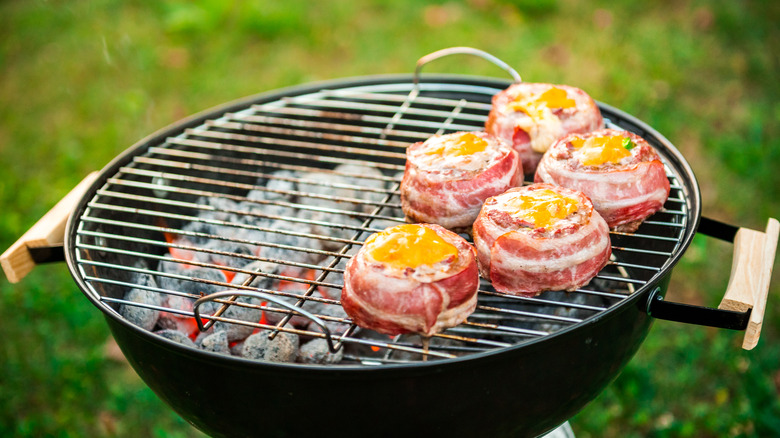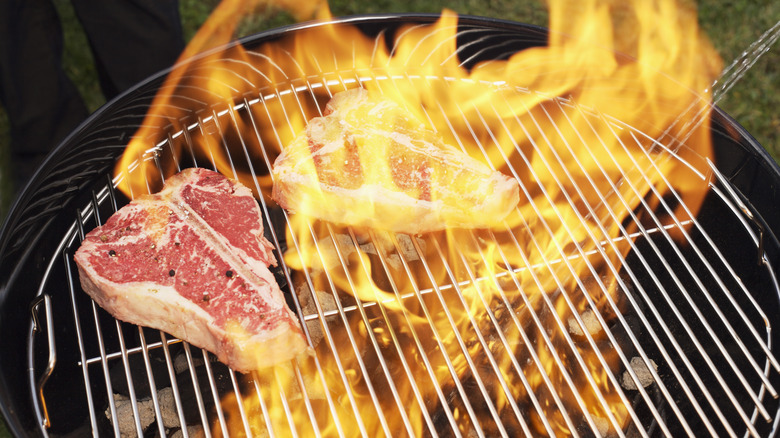The Beginner's Guide To Grilling Like A Master
Whoever concocted the idea of inserting open grate, open flame grills in the middle of a park on the edge of lakes and beaches everywhere surely came up with the most genius idea perhaps in the history of mankind. The barbecue grill is an invention that is second only to fire, though without that fiery invention, your favorite grill time in the park or even in the backyard wouldn't quite be possible. Fire under your food just does something to recipes that cooking in a pan does not.
Becoming a grill master of note means you have mastered the flame, with all the nuances and chemical reactions that come with cooking over an open fire. Sometimes, this requires you to have just the right tools or just the right marinade for things to come out as planned. At other times, it really does mean mastering the flame to the point where you can create zones of heat that allow you to sear steaks to perfection, while at the same time roasting a whole chicken. The best grill masters do this without having to cook one of these items on the grill and the other one on the stove.
Fortunately, with the right know-how and dedication, becoming a grill master is also within your grasp. If you're a beginner, have no fear. This guide will teach you how to create grilled vegetables, steaks, sausages, and even your favorite grilled tofu recipe with ease, whether you're beachside or not.
Clean the grill
When you're grilling a big, juicy ribeye steak, the last thing you want is for it to taste like bits of hot dog, grilled pineapple, and leftover baked potatoes. However, if you don't have some handy grill-cleaning tricks that you employ on the regular, this eventuality and many worse ones could come to pass as these stuck food bits start to get rancid.
The best-tasting ribeye, grilled vegetables, or anything else tastes best when it's cooked on a clean grill. You don't cook food in dirty pots and pans. Cooking food on a dirty grill is akin to doing the same.
Aside from this, bits of food left over on your grill pose a health risk. As the dried and cooked food ages, bacteria and mold. These leave you susceptible to illness because the possibility of cross-contamination is very high. Grilled meat droppings, the kind that leaves black skids on the grill, contain carcinogens that form when the fat from meat burns to the grill. A dirty grill is also responsible for the sticking-food syndrome. When you're grilling something, it winds up sticking to the grill because of all of the old food that is still stuck on it.
And speaking of sticking, be sure to add some oil to the grill before you start cooking. It'll make it easier to clean the grill the next time around because the food won't stick to the grill as much.
Make sure the grill is hot enough
Having a hot enough grill solves all sorts of issues that come up when you're cooking on the barbecue. First and foremost, you'll notice that food won't stick to the grill quite as often, provided that the grill is clean. A conductive heat forms, which prevents sticking. Gas grills heat up very quickly, so if time is also of the essence, consider cooking on a gas grill if that's an option. And as a bonus, the hot grill creates those crunchy lines of grilled deliciousness that make barbecued food taste so great.
That said, there is a drawback. If the grill gets too hot, you'll end up with food that is extremely well done on the outside and still raw on the inside. If you've ever cut into a piece of chicken that was crispy on the outside and pink on the inside, you know what this is like. Of course, your pink chicken comes with more than a pretty-in-pink complexion. Illness can set in because bacteria, like salmonella, which is in the raw meat, hasn't been cooked out.
However, your hot grill can help here, too, if you manage to cook everything all the way through. For example, poultry needs to be cooked at 165 F. The hotter the grill, the more likely you are to cook out bugs that can harm you.
You should grease the grill
Just as you would grease a pan before you cook, you should also grease your grill. And it's for the same reason that you grease your pan that you would also grease the grill— you don't want food to stick to it.
Fortunately, getting grease on the grill is easy. An oil-soaked paper towel offers the simplest way to do it. Just dip the crumpled paper towel into the neutral oil of your choice, and rub the towel all over the grill. Avocado oil, saffron oil, and refined coconut oil count among the best choices for your grill grease. Keep in mind that less equals more in this instance. Avoid putting so much oil on the grill that it's dripping like water droplets off the grill. Too much oil causes grill fires.
If you'd like to dress things up a bit, create a dedicated grill towel for this. A plastic container with a lid holds the towel. To create the grill towel, take a clean bar towel that doesn't have a lot of "pills." Linen works well. Roll it up and tie the end with twine so that it looks like a mini yoga mat with a twine tie at the end. This keeps that end closed. Dip the open end of the towel into your oil and rub it all over the grill. Once you're done, place the towel into the plastic bucket until the next time.
Keep dedicated tools on hand
The proper setup for your grill doesn't start and end with a grill itself. You also need a set of dedicated grill utensils, which are tools that will make grilling not only easier and more pleasurable but safer, too. A good basic set includes tongs, a spatula, a grill brush and a basting brush, a thermometer, and grilling gloves. A dedicated cutting board might be helpful, too, if you have the space near your grill.
Plan on using these specific tools for your barbecue area only. They should be cleaned regularly, as should the area around it. Make sure your tool storage area is as sanitary as a hospital scalpel. Taking this step prevents cross-contamination. If you're cutting raw meat at the grill before you cook it, the surface of that cutting board should only be used for handling raw meat and be cleaned regularly to rid the cutting board of bacteria, like salmonella. Raw meat, in general, should be kept away from other food. And if you're handling the raw meat with your grill utensils, give them a good washing before you use them for any other thing that you're grilling. Or better yet, buy yourself a second set for other food items, like grilled fruits and veggies.
Allow meat to sit for a bit
The only thing more tantalizing than smelling a juicy steak on the grill is cutting into the first mouth-watering bite, preferably right as you take it off the grill. Or so that's the prevailing thought. However, cutting into it straight away actually does your steak, or any other meat for that matter, a disservice.
There's a phenomenon called carry-over cooking, and basically, it means that the heat remains inside of the meat for a couple of minutes even after you take it off the grill. There will be carry-over cooking time for a couple of minutes, which is why you want it to just sit for a bit. It's not necessary to let your meat sit for very long. Unless it's a roast, which requires about 15 to 20 minutes of sitting time, a steak or some chicken may only need 5 or 10 minutes.
And those juices that you love? It is the proverbial stew-in-their-own-juice kind of thing here. The heat makes the muscle fibers in different kinds of meat contract. Any moisture in and around those fibers gets pushed out and up toward the surface. While this makes the steak juicy on the exterior, it can actually dry it out because the juice seeps out of the meat. But when you let the meat sit, the juices settle again, and you wind up with a juicier piece of meat in the process.
Muffin tins make serving condiments easy
Trying to haul different bottles and jars of condiments to and from the grill and the kitchen makes for a lot of work and possibly a mess. But condiments don't need to be in bottles and jars when you grill. In fact, there's an argument to be made for taking them out of their original container and putting them into something that makes them easier to not only carry but to handle.
Enter the muffin tin. Depending on the size you get, you could easily have an individual cup in the tin for ketchup, mustard, mayo, relish, sliced onions, sliced tomatoes, and more. If you're afraid that you'll run low because you're having a big party, create two (or more) tins.
A couple of advantages come with this. First of all, it prevents you from having to carry all those bottles and jars around. Aside from the fact that you run the risk of dropping them, you'll face lots of people handling those bottles and jars. The best-case scenario here is just fingerprints on the side of them. The worst-case scenario could go into cross-contamination territory.
Secondly, once you're done with your grill time, all you need to do is wash the muffin tin and put it away for next time. No juggling bottles and jars. It's just a simple wash with no broken bottles or spilled condiments in the process.
A grill basket is your friend
Foods with quite a lot of girth, like steak or chicken breasts, don't have a problem staying on the grill. But what about the items that you cook to go with them, like sliced peppers and onions for fajitas? How do you cook those without having them fall into the fire mid-cook? You add a grill basket.
A grill basket is a square metal basket with holes in it. Sometimes, it's made of sturdy wire mesh. The purpose is the same regardless of what kind it is. When you have small bits of food to cook, like potatoes, bite-size pieces of meat, or chopped onions, and you want them to taste like the smoke of the grill, you put them in a grill basket. The basket is then placed over the barbecue where the food can cook without falling into the coals and soak up that hickory smoke flavor in the meantime.
This tool, though pretty basic, can revolutionize your barbecue grill recipes. You'll never look at foods like fajitas the same way after you've grilled some peppers and onions in a grill basket. It's worth a try.
Give your food breathing room on the grill
To crowd or not to crowd? That is the question when you're grilling meat, shish kabobs, and other items. Some apprentice grill masters feel tempted to load their grills with as many items as possible, the idea being that dinner will be ready sooner because everything is on the grill all at the same time. However, the thought that this will make things cook faster or better, or even that it's safe, is a fallacy.
Here's how this unpacks. First, a crowded grill equals soggy food, which puts the kibosh on the Maillard reaction. While the name might be unfamiliar to you, the effects of this phenomenon are likely something you know well. It's the chemical reaction that causes your food to brown and become juicy on the inside. The Maillard reaction doesn't work if there's moisture on the grill.
Secondly, a cluster of chicken thighs, filet mignon, sausage, and pork chops (or whatever) causes drips. Those greasy drips are responsible for the fiery flare-ups that occasionally strike your grill. The likelihood that you'll have flare-ups increases when you overcrowd the barbecue. Therefore, your best bet is to separate things well on the grill when you're cooking.
Meat and vegetables grill differently
Grilling meat and vegetables together at the same time presents a bit of a juggling act. Each requires different cooking times as well as different temperatures. If you don't play your cards right, you'll wind up with either burnt, crispy vegetables or raw meat. And that only counts as some of the mistakes you might make when grilling vegetables or meat.
You should grill vegetables at between 400 F and 425 F (though there are some exceptions). This equates to medium-high heat. You'll cook them without the lid on so that the vegetables can sear on the grate. Once they're done, put them on a source of indirect heat to keep them warm.
On the other hand, the temperatures required for grilling meat vary widely depending on the kind of meat you're cooking. For example, a thick steak cooks at a high temperature and will have an internal temperature of somewhere between 115 F and 150 F, depending on your preference. Thinner cuts of steak may only require medium heat to cook. Other meats, like chicken, also have their temperature requirements when you're grilling, so it's possible to have two different kinds of meat cooking on the grill that require two different temperatures. In light of this, it's best to check the recipe in your grill book for grilling best practices.
Good marinades makes a difference
Perfect marinade recipes for the grill are actually, in concept, very simple things. There is a bit of fat, like olive oil, a bit of acid, like lemon, and a little, or even a lot, of spices and herbs. True enough, they make your meats and vegetables taste great, particularly when the flavor of the marinade mixes with the flavor of the barbecue smoke. For something so simple, they add an awful lot to your grilling experience.
The best marinades make your grilled meat more tender, juicy, and moist. The acids in them break down the fibers in the protein, practically turning your chicken, beef, pork, and other proteins into butter in your mouth. The oils, which can include mayonnaise, seal in the juice and moisture. And of course, all the herbs and spices add that certain je ne sais quoi to the taste. It's also worth noting that it isn't just meat that benefits from a marinade. Your vegetables and even your grilled fruit take on a little something extra as well when you soak them in marinade first.
Use heat zones to ensure cooking quality
Masterful grill cooking requires you to learn about direct and indirect heat. With these two temperatures on your grill, you give yourself more options on how you to cook and what to cook. Creating two different cooking zones on a grill gives you the flexibility to cook whole meals on the grill.
To get started on a charcoal grill, fill one side of your grill with charcoal and leave the other side empty. The side with charcoal, clearly, will be the hotter zone. This is where you grill meat, kabobs, and even vegetables. It's the direct part of the direct/indirect heat equation. If you need seared meat, this is the place to do it. With a gas grill, you only need to adjust the knobs on different parts of the barbecue to create different temperature zones.
The side where there is no charcoal (or flame in the case of the gas grill) constitutes the indirect part of the grilling game. Whereas you might cook with the barbecue grill lid up when you're cooking with direct heat, cooking with indirect heat often asks you to cook with the lid down over the food. It also allows you to cook food that requires longer cooking times. For example, whole birds, roasts, or fish thrive on this side of the grill.
Charcoal grills add tons of flavor
Gas barbecue grills bring convenience to your outdoor cookout. Charcoal grills, on the other hand, bring that smoky flavor that smacks of summertime picnics set against a twilight sky. In other words, the flavor difference between a charcoal grill and a gas grill is quite dramatic and nostalgic even in these days of gas grills and convenience.
With gas grills, you're looking at the same ol', same ol' from the flavor perspective unless you get really good at working with marinades. With the charcoal grill, marinades are still an option, but the flavor of the charcoal, combined with different types of wood chips, adds an additional layer of flavor that gas grills just can't.
Aside from this charcoal grills tend to burn hotter. It's the hot grill that creates that Maillard reaction. Meat needs to caramelize under the effects of heat for this to happen, and when it does, you get that crisp, caramelized exterior that makes biting into grilled steak or pork chops so pleasurable.
